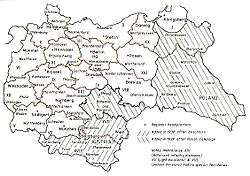Reichsgau Wartheland
| Reichsgau Wartheland | ||||||
| Reichsgau of Nazi Germany | ||||||
| ||||||
| ||||||
 subdivisions (Gaue and Reichsgaue). | ||||||
| Capital | Posen | |||||
| Gauleiter | ||||||
| • | 1939–1945 | Arthur Greiser | ||||
| History | ||||||
| • | Establishment | 2 November 1939 | ||||
| • | German surrender | 8 May 1945 | ||||
| Today part of | | |||||
The Reichsgau Wartheland (initially Reichsgau Posen, sometimes called Warthegau) was a Nazi German Reichsgau formed from Polish territory annexed in 1939. It comprised the Greater Poland and adjacent areas, and only in part matched the area of the similarly named pre-Versailles Prussian province of Posen. The name was initially derived from the capital city, Posen (Poznań), and later from the main river, Warthe (Warta).
The bulk of the area had been annexed by the Kingdom of Prussia from 1793 until 1807 as South Prussia. From 1815 to 1849, the territory was within the autonomous Grand Duchy of Posen, which was the Province of Posen until Poland was reestablished in 1918–1919 following World War I.
Characteristics
- Area: 43,905 km²
- Population: 4,693,700 (1941)
The territory was inhabited by Poles and a German minority (16.7% of total population in 1921). During World War II 630,000 Poles and Jews were expelled from the territory into the occupied General Government (more than 70,000 from Poznań alone) in actions called the Kleine Planung.
Invasion and occupation





A series of staged German attacks near the German-Polish border provided a pretext for invasion of Polish territory in 1939.
After the invasion of Poland, the conquered territory was partitioned among four different Reichsgaue and the General Government area further east. Militärbezirk Posen was created in September 1939 and as Reichsgau Posen annexed by Germany on 8 October 1939, with SS Obergruppenfuhrer Arthur Greiser as the only Gauleiter. The name Reichsgau Wartheland was introduced on 29 January 1940.
The Wehrmacht established Wehrkreis XXI based at Poznań. This Wehrkreis was under the command of General der Artillerie Walter Petsel, and its primary operational unit was the XXXXVIII Panzer Korps. Poznań was responsible for the Militärische Unterregion-Hauptsitze at Poznań, Leszno, Inowrocław, Włocławek, Kalisz, and Łódź. It maintained training areas at Sieradz and Biedrusko.
In the Wartheland, like in most Polish territories annexed by Germany, the Nazis' goal was complete "Germanization" of the territory and its populace.[1] This plan also included settling Germans from the Baltic and other regions on farms and other homes formerly occupied by Poles and Jews.[2] By the end of 1940, 325,000 Poles and Jews from the Wartheland and the Polish Corridor were expelled to General Government, often forced to abandon most of their belongings.[3] Fatalities were numerous. In 1941, the Nazis expelled a further 45,000 people, and from autumn of that year they "began killing Jews by shooting and in gas vans, at first spasmodically and experimentally."[4] Greiser wrote in November 1942: "I myself do not believe that the Führer needs to be asked again in this matter, especially since at our last discussion with regard to the Jews he told me that I could proceed with these according to my own judgement."[5] By 1945 nearly half a million Volksdeutsche Germans had been resettled in the Gau.
End of war
At the beginning of 1945, Soviet forces drove the retreating Germans through the Polish lands. Most resident German citizens fled westwards, many too late due to restrictions by their own government and the fast expanding Red Army. An estimated 50,000 of the former German residents perished, some from flight conditions in severe winter temperatures, some from the atrocities committed by conquering Soviet soldiers and some were killed by vengeful Polish civilians. Over the coming months, the remaining German population was expelled to Germany.[6]
See also
- History of Poland (1939–1945)
- World War II atrocities in Poland
- Special Prosecution Book-Poland
- Intelligenzaktion
- Volksdeutscher Selbstschutz
Notes
- ↑ "Poles: Victims of the Nazi Era". United States Holocaust Memorial Museum. Retrieved 24 May 2013.
- ↑ Lynn H. Nicholas, Cruel World: The Children of Europe in the Nazi Web pp. 207-9, ISBN 0-679-77663-X
- ↑ Lynn H. Nicholas, Cruel World: The Children of Europe in the Nazi Web pp. 213-4, ISBN 0-679-77663-X
- ↑ Max Hastings, "The Most Evil Emperor," NYRB October 23, 2008, p. 48.
- ↑ Ian Kershaw, Hitler, the Germans, and the Final Solution (Yale University Press, 2008), p. 75.
- ↑ Naimark, The Russians in Germany. p. 75 reference 31
Sources
- Anetta Głowacka-Penczyńska, Tomasz Kawski, Witold Mędykowski, Tuvia Horev (red), The First to be Destroyed: The Jewish Community of Kleczew and the Beginning of the Final Solution, Academic Studies Press, Boston, 2015, ISBN 9781618112842
- Shoa.de - List of Gaue and Gauleiter (German)
- Die NS Gaue at the Deutsches Historisches Museum website (German)
- Die Gaue der NSDAP (German)
Coordinates: 52°24′00″N 16°55′00″E / 52.400000°N 16.916667°E
.svg.png)
.svg.png)